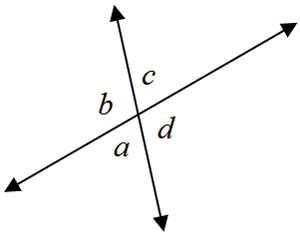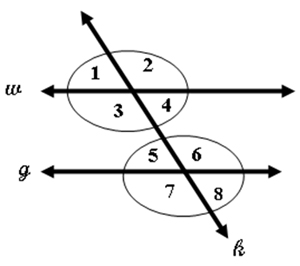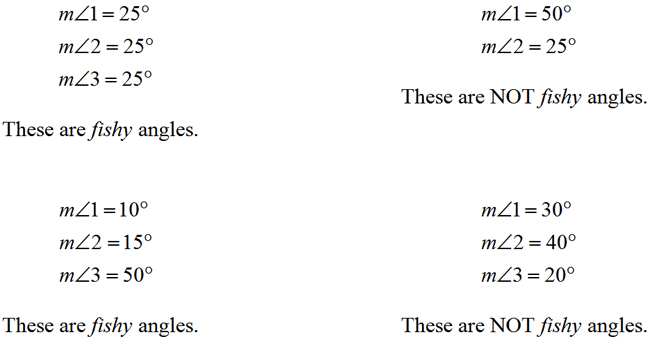
What is true about ∠c and ∠b?

A. They are vertical angles.
Incorrect. Angle c and angle b form a linear pair.
B. They are complementary angles.
Incorrect. Angle c and angle b form a linear pair.
C. They are a linear pair.
Correct! These 2 angles are adjacent angles and together they form a line.
D. They are corresponding angles.
Complementary angles are 2 angles whose sum is 90 degrees. ∠1 and ∠2 are complementary angles. The m∠1 = 2x + 15 and the m∠2 = 3x.
Which conjecture concerning these 2 angles is true?
A. The m∠1 is equal to m∠2.
Correct! Each angle measures 45 degrees.
B. The m∠1 is greater than m∠2.
Incorrect. Set each angle equal to each and solve for x.
C. The m∠1 is less than m∠2.
Incorrect. Set each angle equal to each and solve for x.
D. m∠1 and m∠2 are corresponding angles.
Incorrect. Set each angle equal to each and solve for x.
Lines w and g are parallel. Line k is the transversal.

Why is ∠8 congruent to ∠4?
A. They are complementary angles.
Incorrect. Angle 8 and angle 4 are corresponding angles.
B. They are corresponding angles.
Correct! They are located on the same side of the transversal and are situated the same way on the parallel lines.
C. They are supplementary angles.
Incorrect. Angle 8 and angle 4 are corresponding angles.
D. ∠8 and ∠4 are not congruent.
Incorrect. Angle 8 and angle 4 are corresponding angles.
Consider the following sets of angles.

What conjecture could you make about fishy angles?
A. Fishy angles have equal measures.
Incorrect. Not all fishy angles have equal measures.
B. Fishy angles are 3 angles whose sum is 75 degrees.
Correct! To be considered a fishy angle, there must be 3 angles and the sum of the angles must be 75 degrees.
C. Fishy angles are adjacent angles.
Incorrect. Since we are not given a diagram, we do not know if the given angles are adjacent.
D. Fishy angles are 3 angles.
Incorrect. There is more to being fishy angles than just having 3 angles.